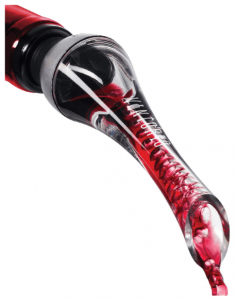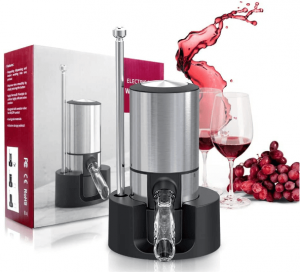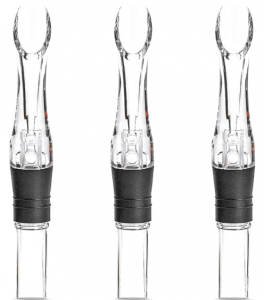Wine aerators are designed to introduce oxygen into the wine, allowing it to breathe and release its full flavor potential. Oxidation is a natural process that occurs when the wine is exposed to air, and it usually takes place over the course of days or weeks. However, aeration can speed up this process, allowing the wine to reach its peak flavor profile in just a few minutes.
Wine aerators come in a variety of shapes and sizes, but they all work by drawing in air and mixing it with the wine as it pours. This aeration process enhances the flavor of wine, making it more smooth and complex. In addition, it can also help to soften the tannins in wine, making it more approachable and enjoyable. Whether you’re a casual wine drinker or a seasoned connoisseur, a quality aerator is an essential tool for enjoying your favorite wines at their best.
Contents
Things To See In A Wine Aerator
-
Features
Just like there is a myriad of wine aerators to choose from, the same is true for their features. There are some aerators that offer extra-fancy features, whereas there are other options that just provide the basic features. An easy grip feature in wine aerators ensures a tight grip when you perform the aeration.
In the same way, anti-drip features provided by aerators ensure that the oxidation and evaporation procedures take place without leaving behind any unnecessary mess.
Aerators that can be compressed after use are relatively space-efficient.An easy push feature is a feasible choice if you’re a beginner in the world of aeration and want smooth conduction of the procedure. With the advancements in technology, we now have all-in-one aerators that reduce the number of devices you require for the aeration process.
-
Ease Of Use
There are different types of wine aerators to choose from. While some are manual, others operate on electricity. If you want to aerate your wine kept idle in your wine rack, but exert the minimum possible effort, you can opt for an electric aerator. In such aerators, all you need to do is push the START button and the aerator will do everything itself.
-
Effectiveness
The effectiveness of the wine aerator is undoubtedly a vital factor to consider. There are several people out there who prefer an aerator that can transform their wine drinking experience into a luxurious one irrespective of the original cost of the wine. If you’re one of them, make sure you analyze the technique used by the aerator as well as the reviews provided by fellow oenophiles.
-
Style And Design
Wine aerators come in varied styles and designs. The primary features to choose from, however, come down to the power source, the method of aeration, the ease of use, and the primary functions performed by it. Almost every wine aerator is small and lightweight.
They can either be positioned over the mouth of the decanter or fit into the neck of the wine bottle. A simple aerator doesn’t have any power requirements, but if you choose to opt for an advanced aerator, you’ll need gas cartridges or batteries to operate them smoothly.
-
Easy Cleaning
Generally, almost every wine aerator offers ease of cleaning. There are some wine aerators that are dishwasher safe. Yet there are others that need to be washed by hand. To wash such wine aerators, you can simply use a mild soap and lukewarm water. Run the water through the aerator till no suds can be found.
The 8 Best Wine Aerators In 2024
Best Overall: Vinturi Red Wine Aerator

The Vinturi red wine aerator is a small, hand-held tool that is used to aerate wine. The aerator has a small hollow chamber that is filled with wine.
This aerator has a capacity of 750 milliliters, making it perfect for red wine. It features patented technology that accelerates the breathing process, allowing the wine to reach its full potential.
As the wine is poured into the chamber, it is forced through a narrow opening. This causes the wine to come into contact with air, which allows it to breathe.
The aerator also has a small hole in the bottom that releases any excess air. This helps to ensure that the wine is properly aerated.
It is an easy and convenient way to aerate wine. It is also very affordable, making it a great option for those who do not want to spend a lot of money on a wine aerator.
Pros
Cons
Best In Budget: VINVOLI Wine Aerator

This small and lightweight aerator has a 0.15-liter capacity and 6″W x 2″H dimensions, making it perfect for taking with you on the go.
It aerates your wine by using a two-step process that first oxygenates the wine and then allows it to breathe.
Simply place the aerator over the glass and pour the wine through it. The aerator will instantly oxygenate the wine, bringing out its full flavor and aroma.
It also has a unique removable mesh screen extracts sediment filtering system that removes sediments and impurities, ensuring that you always enjoy a smooth, crisp glass of wine.
Pros
Cons
Best In Value: Centellino Areadivino Wine Aerator

With a capacity of 125 milliliters, it is the perfect size for most wine bottles. The aerator has a sleek and modern design that will look great on any countertop.
This is also easy to store and clean, making it the perfect tool for any wine lover. It comes with a detachable base that makes it easy to clean.
It aerates and oxidizes wine without causing any trauma to the wine. So far, the reviews have been mixed.
Pros
Cons
Best In Electric: Aervana Original Wine Aerator

This wine aerator has a sleek, compact design that takes up minimal counter space, and it comes with everything you need to get started, including an air pump, aeration tube, and base.
This is easy to use; simply place the aeration tube in your bottle of wine and let the electric pump do the work.
It provides 6x times the aeration of typical gravity aerators, quickly and easily delivering smooth, flavorful wine with no sediment or bitterness.
Designed for both red and white wines, it’s perfect for anyone who wants to enjoy their wine at its best. Also, it includes PET food-safe plastic tubes.
Pros
Cons
Best Lightweight: Vintorio Wine Aerator Pourer

The Vintorio wine aerator pourer is made of high-quality materials. This aerator pourer has a 5.9″W x 1.1″H dimension and it only weighs 0.08 pounds.
This aerator pourer has a large aerating chamber and air intake system that utilizes the Bernoulli Effect to evenly infuse your wine with oxygen.
The result is a glass of wine that has been perfectly aerated and has a smooth, rich flavor. With this aerator pourer, you will be able to easily aerate your wine without any hassle.
The rubber stopper is tapered and ribbed to create a leak-free seal, and the aerator allows you to pour a perfect glass of wine every time. The aerator also prevents drips, so you can enjoy your wine without worry.
Pros
Cons
Best In Design: Rocyis Electric Wine Aerator

This innovative device aerates your wine in just 6 seconds, allowing you to enjoy perfectly aerated wine without any waiting. And because it’s electric, there’s no need for batteries.
With the touch of a button, this appliance quickly and easily aerates your wine, allowing you to enjoy its full flavor in just minutes.
This aerator comes with an adjustable tube that allows you to customize the amount of aeration, and it also has an easy-to-clean design.
It also comes with FCC, CE, and RoHS certification, which means it meets high safety and quality standards. So you can rest assured that your wine is in good hands with this appliance.
Pros
Cons
Best Air Speed: TRIBELLA Wine Aerator

It has a compact and pioneering design that makes it a must-have tool for wine lovers. Its 8.9″W x 0.3″H dimensions mean that it can easily be stored in a drawer or cabinet.
The best feature of this aerator is its innovative air injection system, which oxygenates the wine as it is poured, allowing for a smoother, more flavorful taste.
This aerator features a polycarbonate base and a rubber gasket, which work together to ensure perfect aeration each and every time.
Its patented design features 3 engineered exit pipes.
Pros
Cons
Best Bottle-Top: Cork Genius Wine Aerator

This compact aerator has dimensions of 0.28 x 0.2 x 0.28 inches, making it easy to store in a drawer or cupboard. It also features an ergonomic, tight-seal design that makes it easy to use.
Simply place the aerator over the neck of a wine bottle and pour. The aerator will instantly infuse your wine with oxygen, helping to bring out its flavor and aroma.
The aerator also includes a drip-free pouring spout, making it easy to enjoy your wine without making a mess. It is made with easy-to-clean acrylic material, so you can aerate your wine without any hassle.
Pros
Cons
Difference Between A Wine Aerator And Wine Decanter
In simple terms, a wine aerator is an ideal option for young wines and specifically for big, bold, and tannic reds. On the other hand, a wine decanter is well-suited to be used for more delicate bottled wines and older wines.
A wine aerator performs the process of filtering air into wine at a quicker pace in order to release significantly more flavors and aromas from the wine. In contrast, a wine decanter serves as a vessel that is used to hold wine before drinking to filter out the sediments.
Both wine aerator and wine decanter come with their respective merits and demerits. A wine aerator offers ease of cleaning and is a cost-effective device. However, it is not a feasible option for red and white wines. A wine decanter, on the other hand, can decant red and white wines with relative perfection. What comes as a drawback of wine decanter is its cost and the time period it demands for the decantation process.
FAQs
The primary purpose of a wine aerator is to facilitate the interaction between wine and air that leads to evaporation and oxidation. This objective is achieved by the passage of wine through a funnel consisting of pressurized oxygen. The exposure of wine to unexpectedly high levels of oxygen leads to the oxidation of its compounds.
The alcohol contained in the wine is, therefore, converted into acetic acid and acetaldehyde. This in turn reduces the medicinal characteristic that is usually prominent in a wine’s bouquet. The second vital chemical reaction accelerated by wine aerators is evaporation. The extra molecules of sulfites and ethanol are removed effectively through this process. In short, the aerators perform the function of grooming the wine.
People have varying opinions when it comes to decanting wine. It is suggested that old or fragile wines i.e. wines that are 15 or more years old must be decanted for 30 minutes or so before it is set for drinking. On the other hand, red wines that are comparatively younger and even white wines can undergo decantation for an hour or more before they’re ready to be served.
The wine bottles are properly sealed for a reason- to protect them from excess air. In fact, if the duration of exposure is excessive, it can turn into vinegar. If you don’t take the necessary precautions to protect your wine from exposure to air, its taste will eventually begin to fade away.
More often than not, white wines need not be aerated. However, the ones that do require aeration usually have a considerable amount of flavor in them. Some of these wines are Burgundies, Alsace, Chardonnays, White Bordeaux, and Sauvignon Blancs.
The white wines that are lighter don’t require aeration. Nonetheless, if you’re genuinely interested and willing to aerate white wine, there’s nothing stopping you from doing that.
There are three ways to aerate wine. In the first method, you place the filter over the wine aerator. Then you place your wine glass on a flat surface for pouring the wine. Once positioned, hold the aerator over your glass in such a manner that it doesn’t block the air holes. Lastly, pour the liquid through the wine aerator.
In the second method, you snap the aerator pourer to the opened wine bottle. Thereafter, slowly pour the wine into a wine glass that is placed on a stable and flat surface. Once done, simply seal the wine bottle using a wine stopper or by employing the twist-top mechanism.
In the third and the last method, you employ an automatic aerator. Firstly, assemble the parts of the aerator by following the instructions provided in the manual. Then fasten the automated aerator to the mouth of the wine bottle. Once done, make sure you position your wine glass below the spout at a specific angle. Press the dispense button on the aerator and once you’re done pouring, re-cork your wine bottle.
The duration of aeration depends upon the grape and the style of the wine. Red wines generally benefit the most from aeration before serving. Nonetheless, there are other wines whose flavor improves with little exposure to air. Typically, most wines improve with an aeration of 15-20 minutes. However, if the wine is young and has high tannin levels, it’ll require a longer aeration period before being ready to drink.
Over-aerating wine is a possibility. The primary reason behind storing wine in sealed bottles is to prevent exposure to oxygen. If the wine is exposed to oxygen for long, it will have a nutty and old taste, thereby lacking its personality. In fact, if it is exposed to air for a considerably longer period of time, chances are it’ll turn into vinegar.
The function served of a wine aerator is to expose the wine to air and therefore, improve its taste. Consider, for instance, a bottle of wine that claims you’ll experience flavors of cloves, blackberry, and cherry. To taste such flavors deeply, you can use an aerator. Additionally, a wine aerator can help soften some flavors, thereby making them more palatable.
Although aeration can significantly enhance the aroma and flavor of a wine, it is a fruitful option only if you genuinely like the wine. Aeration in itself is no magic. In a worst-case scenario, moreover, aeration can enhance the flaws in a wine, such as brett or TCA. Therefore, aeration does make the wine taste better provided you do it in a skillful manner.
As a rule of thumb, most red wines must be aerated. Some of them such as Petite Seroh and Merlot are likely to benefit the most from aeration. Although it isn’t a necessity to aerate white wine, you can still choose to do that if the taste of your wine doesn’t seem pleasant to you

